Iron-Copper-Zinc Isotopic Compositions of Andesites from the Kueishantao Hydrothermal Field off Northeastern Taiwan
Abstract
:1. Introduction
2. Geological Setting
3. Samples and Methods
3.1. Fe, Cu, and Zn Isotope Analytical Methods
3.1.1. Cu and Zn Isotope Analyses
3.1.2. Fe Isotope Analyses
4. Results
5. Discussion
5.1. Fe-Cu-Zn Isotopic Fractionations during Magma Evolution
5.1.1. Fe Isotopes
5.1.2. Cu Isotopes
5.1.3. Zn Isotopes
5.2. Fe-Cu-Zn Isotope Heterogeneities in the Taiwan Continental Crust
5.2.1. Fe-Cu-Zn Isotope Composition of Taiwan Continental Crust
5.2.2. Sources Controlling Fe-Cu-Zn Isotope Heterogeneities in the Taiwan Continental Crust
6. Conclusions
Author Contributions
Funding
Data Availability Statement
Acknowledgments
Conflicts of Interest
References
- Sharma, M.; Polizzotto, M.; Anbar, A.D. Iron isotopes in hot springs along the Juan de Fuca Ridge. Earth Planet. Sci. Lett. 2001, 194, 39–51. [Google Scholar] [CrossRef]
- Rouxel, O.; Fouquet, Y.; Ludden, J.N. Subsurface processes at the lucky strike hydrothermal field, Mid-Atlantic ridge: Evidence from sulfur, selenium, and iron isotopes. Geochim. Cosmochim. Acta 2004, 68, 2295–2311. [Google Scholar] [CrossRef]
- Mathur, R.; Titley, S.; Barra, F.; Brantley, S.; Wilson, M.; Phillips, A.; Munizaga, F.; Maksaev, V.; Vervoort, J.; Hart, G. Exploration potential of Cu isotope fractionation in porphyry copper deposits. J. Geochem. Explor. 2009, 102, 1–6. [Google Scholar] [CrossRef]
- Li, W.Q.; Jackson, S.E.; Pearson, N.J.; Graham, S. Copper isotopic zonation in the Northparkes porphyry Cu–Au deposit, SE Australia. Geochim. Cosmochim. Acta 2010, 74, 4078–4096. [Google Scholar] [CrossRef]
- Liu, S.-A.; Huang, J.; Liu, J.; Wörner, G.; Yang, W.; Tang, Y.-J.; Chen, Y.; Tang, L.-M.; Zheng, J.-P.; Li, S.-G. Copper isotopic composition of the silicate Earth. Earth Planet. Sci. Lett. 2015, 427, 95–103. [Google Scholar] [CrossRef]
- John, S.G.; Rouxel, O.J.; Craddock, P.R.; Engwall, A.M.; Boyle, E.A. Zinc stable isotopes in seafloor hydrothermal vent fluids and chimneys. Earth Planet. Sci. Lett. 2008, 269, 17–28. [Google Scholar] [CrossRef]
- Zeng, Z.G.; Li, X.H.; Chen, S.; de Jong, J.; Mattielli, N.; Qi, H.Y.; Pearce, C.; Murton, J.B. Iron, copper, and zinc isotopic fractionation in seafloor basalts and hydrothermal sulfides. Mar. Geol. 2021, 436, 106491. [Google Scholar] [CrossRef]
- Yang, W.; Li, S.G. Geochronology and geochemistry of the Mesozoic volcanic rocks in Western Liaoning: Implications for lithospheric thinning of the North China Craton. Lithos 2008, 102, 88–117. [Google Scholar] [CrossRef]
- Churikova, T.; Dorendorf, F.; Worner, G. Sources and fluids in the mantle wedge below Kamchatka, evidence from across-arc geochemical variation. J. Petrol. 2001, 42, 1567–1593. [Google Scholar] [CrossRef] [Green Version]
- Münker, C.; Wörner, G.; Yogodzinski, G.; Churikova, T. Behaviour of high field strength elements in subduction zones: Constraints from Kamchatka–Aleutian arc lavas. Earth Planet. Sci. Lett. 2004, 224, 275–293. [Google Scholar] [CrossRef]
- Abratis, M.; Wörner, G. Ridge collision, slab-window formation, and the flux of Pacific asthenosphere into the Caribbean realm. Geology 2001, 29, 127–130. [Google Scholar] [CrossRef]
- Yogodzinski, G.; Lees, J.; Churikova, T.; Dorendorf, F.; Woerner, G.; Volynets, O. Geochemical evidence for the melting of subducting oceanic lithosphere at plate edges. Nature 2001, 409, 500–504. [Google Scholar] [CrossRef]
- Savage, P.; Chen, H.; Shofner, G.; Badro, J.; Moynier, F. The copper isotope composition of bulk Earth: A new paradox. Goldschmidt Conf. Abstr. 2013, P2142. [Google Scholar]
- Toutain, J.P.; Sonke, J.; Munoz, M.; Nonell, A.; Polvé, M.; Viers, J.; Freydier, R.; Sortino, F.; Joron, J.L.; Sumarti, S. Evidence for Zn isotopic fractionation at Merapi volcano. Chem. Geol. 2008, 253, 74–82. [Google Scholar] [CrossRef]
- Maréchal, C.N.; Télouk, P.; Albarède, F. Precise analysis of copper and zinc isotopic compositions by plasma-source mass spectrometry. Chem. Geol. 1999, 156, 251–273. [Google Scholar] [CrossRef]
- Archer, C.; Vance, D. Mass discrimination correction in multiple-collector plasma source mass spectrometry: An example using Cu and Zn isotopes. J. Anal. At. Spectrom. 2004, 19, 656–665. [Google Scholar] [CrossRef]
- Chen, C.A.; Zeng, Z.G.; Kuo, F.W.; Yang, T.F.; Wang, B.J.; Tu, Y.Y. Tide-influenced acidic hydrothermal system offshore NE Taiwan. Chem. Geol. 2005, 224, 69–81. [Google Scholar] [CrossRef]
- Chen, C.A.; Wang, B.J.; Huang, J.F.; Lou, J.Y.; Kuo, F.W.; Tu, Y.Y.; Tsai, H.S. Investigation into extremely acidic hydrothermal fluids off Kueishantao islet, Taiwan. Acta Oceanol. Sin. 2005, 24, 125–133. [Google Scholar]
- Zeng, Z.G.; Liu, C.H.; Chen, C.-T.A.; Yin, Y.B.; Chen, D.G.; Wang, X.Y.; Wang, X.M.; Zhang, G.L. Origin of a native sulfur chimney in the Kueishantao hydrothermal field, offshore northeast Taiwan. Sci. China Ser. D 2007, 50, 1746–1753. [Google Scholar] [CrossRef]
- Zeng, Z.G.; Chen, C.-T.A.; Yin, X.B.; Zhang, X.Y.; Wang, X.Y.; Zhang, G.L.; Wang, X.M.; Chen, D.G. Origin of native sulfur ball from the Kueishantao hydrothermal field offshore northeast Taiwan: Evidence from trace and rare earth element composition. J. Asian Earth Sci. 2011, 40, 661–671. [Google Scholar] [CrossRef]
- Zeng, Z.G.; Wang, X.Y.; Chen, C.-T.A.; Yin, X.B.; Chen, S.; Ma, Y.Q.; Xiao, Y.K. Boron isotope compositions of fluids and plumes from the Kueishantao hydrothermal field off northeastern Taiwan: Implications for fluid origin and hydrothermal processes. Mar. Chem. 2013, 157, 59–66. [Google Scholar] [CrossRef]
- Zeng, Z.G.; Ma, Y.; Wang, X.Y.; Chen, C.-T.A.; Yin, X.B.; Zhang, S.P.; Zhang, J.L.; Jiang, W. Elemental compositions of crab and snail shells from the Kueishantao hydrothermal field in the southwestern Okinawa Trough. J. Mar. Syst. 2018, 180, 90–101. [Google Scholar] [CrossRef]
- Letouzey, J.; Kimura, M. Okinawa Trough genesis: Structure and evolution of a back arc basin developed in a continent. Mar. Pet. Geol. 1985, 2, 111–130. [Google Scholar] [CrossRef]
- Chung, S.L.; Wang, S.L.; Shinjo, R.; Lee, C.S.; Chen, C.H. Initiation of arc magmatism in an embryonic continental rifting zone of the southernmost part of Okinawa Trough. Terra Nova 2000, 12, 225–230. [Google Scholar] [CrossRef]
- Chen, C.-H.; Typhoon, L.; Shieh, Y.-N.; Chen, C.-H.; Hsu, W.-Y. Magmatism at the onset of back-arc basin spreading in the Okinawa Trough. J. Volcanol. Geotherm. Res. 1995, 69, 313–322. [Google Scholar]
- Chen, Y.G.; Wu, W.S.; Chen, C.H.; Liu, T.K. A date for volcanic-eruption inferred from a siltstone xenolith. Quat. Sci. Rev. 2001, 20, 869–873. [Google Scholar] [CrossRef]
- Petit, J.C.J.; de Jong, J.; Chou, L.; Mattielli, N. Development of Cu and Zn isotope MC-ICP-MS measurements: Application to suspended particulate matter and sediments from the Scheldt Estuary. Geostand. Geoanal. Res. 2008, 32, 149–166. [Google Scholar] [CrossRef]
- Sossi, P.A.; Halverson, G.P.; Nebel, O.; Eggins, S.M. Combined separation of Cu, Fe and Zn from rock matrices and improved analytical protocols for stable isotope determination. Geostand. Geoanal. Res. 2015, 39, 129–149. [Google Scholar] [CrossRef]
- Debret, B.; Beunon, H.; Mattielli, N.; Andreani, M.; da Coata, I.R.; Escartin, J. Ore component mobility, transport and mineralization at mid-oceanic ridges: A stable isotopes (Zn, Cu and Fe) study of the Rainbow massif (Mid-Atlantic Ridge 36°14′ N). Earth Planet. Sci. Lett. 2018, 503, 170–180. [Google Scholar] [CrossRef]
- Ponzevera, E.; Quétel, C.R.; Berglund, M.; Taylor, P.D.P. Mass Discrimination During MC-ICPMS Isotopic Ratio Measurements: Investigation by Means of Synthetic Isotopic Mixtures (IRMM-007 Series) and Application to the Calibration of Natural-Like Zinc Materials (Including IRMM-3702 and IRMM-651). J. Am. Soc. Mass Spectrom. 2006, 17, 1413–1427. [Google Scholar] [CrossRef] [Green Version]
- Moeller, K.; Schoenberg, R.; Pedersen, R.-B.; Weiss, D.; Dong, S. Calibration of the new certified reference materials ERM-AE633 and ERM-AE647 for copper and IRMM-3702 for zinc isotope amount ratio determinations. Geostand. Geoanal. Res. 2012, 36, 177–199. [Google Scholar] [CrossRef] [Green Version]
- Taylor, P.D.P.; Maeck, R.; De Bievre, P. Determination of the absolute isotopic composition and atomic weight of a reference sample of natural iron. Int. J. Mass Spectrom. Ion Processes 1992, 121, 111–125. [Google Scholar] [CrossRef]
- Teng, F.-Z.; Dauphas, N.; Huang, S.; Marty, B. Iron isotopic systematics of oceanic basalts. Geochim. Cosmochim. Acta 2013, 107, 12–26. [Google Scholar] [CrossRef]
- Beard, B.L.; Johnson, C.M.; Skulan, J.L.; Nealson, K.H.; Cox, L.; Sun, H. Application of Fe isotopes to tracing the geochemical and biological cycling of Fe. Chem. Geol. 2003, 195, 87–117. [Google Scholar] [CrossRef]
- Rouxel, O.J.; Maureen, A. Iron Isotope Variations in Coastal Seawater Determined by Multicollector ICP-MS. Geostand. Geoanal. Res. 2010, 34, 135–144. [Google Scholar] [CrossRef]
- Rouxel, O.; Dobbek, N.; Ludden, J.; Fouquet, Y. Iron isotope fractionation during oceanic crust alteration. Chem. Geol. 2003, 202, 155–182. [Google Scholar] [CrossRef]
- Severmann, S.; Johnson, C.M.; Beard, B.L.; German, C.R.; Edmonds, H.N.; Chiba, H.; Green, D.R.H. The effect of plume processes on the Fe isotope composition of hydrothermally derived Fe in the deep ocean as inferred from the Rainbow vent site, Mid-Atlantic Ridge, 36°14′ N. Earth Planet. Sci. Lett. 2004, 225, 63–76. [Google Scholar] [CrossRef]
- Rouxel, O.; Shanks, W.C., III; Bach, W.; Edwards, K.J. Integrated Fe- and S-isotope study of seafloor hydrothermal vents at East Pacific Rise 9–10° N. Chem. Geol. 2008, 252, 214–227. [Google Scholar] [CrossRef] [Green Version]
- Moeller, K.; Schoenberg, R.; Grenne, T.; Thorseth, I.H.; Drost, K.; Pedersen, R.B. Comparison of iron isotope variations in modern and Ordovician siliceous Fe oxyhydroxide deposits. Geochim. Cosmochim. Acta 2014, 126, 422–440. [Google Scholar] [CrossRef]
- Savage, P.; Moynier, F.; Cheng, H.; Shofner, G.; Siebert, J.; Badro, J.; Puchtel, I.S. Copper isotope evidence for large-scale sulphide fractionation during Earth’s differentiation. Geochem. Perspect. Lett. 2015, 1, 53–64. [Google Scholar] [CrossRef] [Green Version]
- Vance, D.; Archer, C.; Bermin, J.; Perkins, J.; Statham, P.J.; Lohan, M.C.; Ellwood, M.J.; Mills, R.A. The copper isotope geochemistry of rivers and the oceans. Earth Planet. Sci. Lett. 2008, 274, 204–213. [Google Scholar] [CrossRef]
- Little, S.H.; Vance, D.; Walker-Brown, C.; Landing, W.M. The oceanic mass balance of copper and zinc isotopes, investigated by analysis of their inputs, and outputs to ferromanganese oxide sediments. Geochim. Cosmochim. Acta 2014, 125, 673–693. [Google Scholar] [CrossRef] [Green Version]
- Dekov, V.; Rouxel, O. Cu- and Zn-isotope systematics of seafloor hydrothermal vent fluids from a back-arc setting (Manus Basin). In Proceedings of the EGU General Assembly, Vienna, Austria, 22–27 April 2012; p. 13020. [Google Scholar]
- Ben Othman, D.; Luck, J.M.; Bodinier, J.L.; Arndt, N.T.; Albarède, F. Cu-Zn isotopic variations in the Earth’s mantle. Geochim. Cosmochim. Acta 2006, 70, A46. [Google Scholar] [CrossRef]
- Chen, H.; Savage, P.S.; Teng, F.-Z.; Helz, R.T.; Moynier, F. Zinc isotope fractionation during magmatic differentiation and the isotopic composition of the bulk Earth. Earth Planet. Sci. Lett. 2013, 369, 34–42. [Google Scholar] [CrossRef]
- Wang, Z.-Z.; Liu, S.-A.; Liu, J.; Huang, J.; Xiao, Y.; Chu, Z.-Y.; Zhao, X.-M.; Tang, L. Zinc isotope fractionation during mantle melting and constraints on the Zn isotope composition of Earth’s upper mantle. Geochim. Cosmochim. Acta 2017, 198, 151–167. [Google Scholar] [CrossRef]
- Zhao, Y.; Vance, D.; Abouchami, W.; de Baar, H.J.W. Biogeochemical cycling of zinc and its isotopes in the Southern Ocean. Geochim. Cosmochim. Acta 2014, 125, 653–672. [Google Scholar] [CrossRef] [Green Version]
- Samanta, M.; Ellwood, M.J.; Sinoir, M.; Hassler, C.S. Dissolved zinc isotope cycling in the Tasman Sea, SW Pacific Ocean. Mar. Chem. 2017, 192, 1–12. [Google Scholar] [CrossRef]
- Pichat, S.; Douchet, C.; Albarède, F. Zinc isotope variations in deep-sea carbonates from the eastern equatorial Pacific over the last 175 ka. Earth Planet. Sci. Lett. 2003, 210, 167–178. [Google Scholar] [CrossRef]
- Polyakov, V.B.; Mineev, S.D. The use of Mössbauer spectroscopy in stable isotope geochemistry. Geochim. Cosmochim. Acta 2000, 64, 849–865. [Google Scholar] [CrossRef]
- Bullen, T.D.; White, A.F.; Childs, C.W.; Vivit, D.V.; Schulz, M.S. Demonstration of significant abiotic iron isotope fractionation in nature. Geology 2001, 29, 699–702. [Google Scholar] [CrossRef]
- Schauble, E.A.; Rossman, G.R.; Taylor, H.P. Theoretical estimates of equilibrium Fe-isotope fractionations from vibrational spectroscopy. Geochim. Cosmochim. Acta 2001, 65, 2487–2497. [Google Scholar] [CrossRef]
- Johnson, C.M.; Skulan, J.L.; Beard, B.L.; Sun, H.; Nealson, K.H.; Braterman, P.S. Isotopic fractionation between Fe(III) and Fe(II) in aqueous solutions. Earth Planet. Sci. Lett. 2002, 195, 141–153. [Google Scholar] [CrossRef]
- Johnson, C.M.; Beard, B.L.; Beukes, N.J.; Klein, C.; O’Leary, J.M. Ancient geochemical cycling in the Earth as inferred from Fe isotope studies of banded iron formations from the Transvaal Craton. Contrib. Mineral. Petrol. 2003, 144, 523–547. [Google Scholar] [CrossRef]
- Weyer, S.; Ionov, D.A. Partial melting and melt percolation in the mantle: The message from Fe isotopes. Earth Planet. Sci. Lett. 2007, 259, 119–133. [Google Scholar] [CrossRef]
- Kunzmann, M.; Halverson, G.P.; Sossi, P.A.; Raub, T.D.; Payne, J.L.; Kirby, J. Zn isotope evidence for immediate resumption of primary productivity after snowball Earth. Geology 2013, 41, 27–30. [Google Scholar] [CrossRef]
- Liu, S.-A.; Wang, Z.-Z.; Li, S.-G.; Huang, J.; Yang, W. Zinc isotope evidence for a large-scale carbonated mantle beneath eastern China. Earth Planet. Sci. Lett. 2016, 444, 169–178. [Google Scholar] [CrossRef]
- Telus, M.; Dauphas, N.; Moynier, F.; Tissot, F.L.H.; Teng, F.Z.; Nabelek, P.I.; Craddock, P.R.; Groat, L.A. Iron, zinc, magnesium and uranium isotopic fractionation during continental crust differentiation: The tale from migmatites, granitoids, and pegmatites. Geochim. Cosmochim. Acta 2012, 97, 247–265. [Google Scholar] [CrossRef]
- Sun, H.; Xiao, Y.; Gao, Y.; Lai, J.; Hou, Z.; Wang, Y. Fluid and melt inclusions in the Mesozoic Fangcheng basalt from North China Craton: Implications for magma evolution and fluid/melt-peridotite reaction. Contrib. Mineral. Petrol. 2013, 165, 885–901. [Google Scholar] [CrossRef]
- Li, X.H.; Zeng, Z.G.; Chen, S.; Ma, Y.; Yang, H.X.; Zhang, Y.X.; Chen, Z.X. Geochemistry and Sr–Nd–Pb isotopic of volcanic rocks from Iheya Ridge, the middle Okinawa Trough: Implications for the petrogenesis and mantle source. Acta Oceanol. Sin. 2018, 37, 73–88. [Google Scholar] [CrossRef]
- Li, X.H.; Zeng, Z.G.; Yang, H.X.; Yin, X.B.; Wang, X.Y.; Chen, S.; Ma, Y.; Guo, K. Geochemistry of silicate melt inclusions in middle and southern Okinawa Trough rocks: Implications for petrogenesis and variable subducted sediment component injection. Geol. J. 2018, 54, 1160–1189. [Google Scholar] [CrossRef]
- Chen, C.-H.; Jahn, B.M.; Lee, T.; Chen, C.H.; Connichet, J. Sm-Nd isotopic geochemistry of sediments from Taiwan and complication for the tectonic evolution of SE China. Chem. Geol. 1990, 88, 317–332. [Google Scholar] [CrossRef]
- Lan, C.Y.; Lee, T.; Wang Lee, C. The Rb-Sr isotopic record in Taiwan Gneisses and its tectonic implication. Tectonophysics 1990, 183, 129–143. [Google Scholar]
- Sun, S.S.; McDonough, W.F. Chemical and isotopic systematics of oceanic basalts: Implications for mantle composition and processes. Geol. Soc. Lond. Spec. Publ. 1989, 42, 313–345. [Google Scholar] [CrossRef]
- Rudnick, R.L.; Gao, S. Composition of the continental crust. In Treatise on Geochemistry; Holland, H.D., Turekian, K.K., Eds.; Elsevier Science Ltd.: Amsterdam, The Netherlands, 2003; Volume 3, pp. 1–64. [Google Scholar]
- Vajk, R. Correction of gravity anomalies at sea for submarine topography. J. Geophys. Res. 1964, 69, 3837–3844. [Google Scholar] [CrossRef]
- Yeh, Y.H.; Lin, C.H.; Roecker, S.W. A study of upper crustal structures beneath northeastern Taiwan: Possible evidence of the western extension of Okinawa Trough. Proc. Geol. Soc. China 1989, 32, 139–156. [Google Scholar]
- Lee, C.S.; Shor, G.G., Jr.; Bibee, L.D.; Lu, R.S.; Hilde, T.W.C. Okinawa Trough: Origin of a back-arc basin. Mar. Geol. 1980, 35, 219–241. [Google Scholar] [CrossRef]
- Poitrasson, F.; Freydier, R. Heavy iron isotope composition of granites determined by high resolution MC-ICP-MS. Chem. Geol. 2005, 222, 132–147. [Google Scholar] [CrossRef]
- Li, W.Q.; Jackson, S.E.; Pearson, N.J.; Alard, O.; Chappell, B.W. The Cu isotopic signature of granites from the Lachlan Fold Belt, SE Australia. Chem. Geol. 2009, 258, 38–49. [Google Scholar] [CrossRef]
- Viers, J.; Oliva, P.; Nonell, A.; Gélabert, A.; Sonke, J.E.; Freydier, R.; Gainville, R.; Dupré, B. Evidence of Zn isotopic fractionation in a soil–plant system of a pristine tropical watershed (Nsimi, Cameroon). Chem. Geol. 2007, 239, 124–137. [Google Scholar] [CrossRef]
- Shields, W.R.; Goldich, S.S.; Garner, E.L.; Murphy, T.J. Natural variations in the abundance ratio and the atomic weight of copper. J. Geophys. Res. 1965, 70, 479–491. [Google Scholar] [CrossRef]
- Zhu, X.K.; O’Nions, R.K.; Guo, Y.; Belshaw, N.S.; Rickard, D. Determination of natural Cu-isotope variation by plasma-source mass spectrometry: Implications for use as geochemical tracers. Chem. Geol. 2000, 163, 139–149. [Google Scholar] [CrossRef]
- Li, J.L.; Klemd, R.; Gao, J.; Meyer, M. Compositional zoning in dolomite from lawsonite-bearing eclogite (SW Tianshan, China): Evidence for prograde metamorphism during subduction of oceanic crust. Am. Mineral. 2014, 99, 206–217. [Google Scholar] [CrossRef]
- Huang, J.; Liu, S.-A.; Gao, Y.; Xiao, Y.; Chen, S. Copper and zinc isotope systematics of altered oceanic crust at IODP Site 1256 in the eastern equatorial Pacific. J. Geophys. Res. Sol. Earth 2016, 121, 7086–7100. [Google Scholar] [CrossRef]

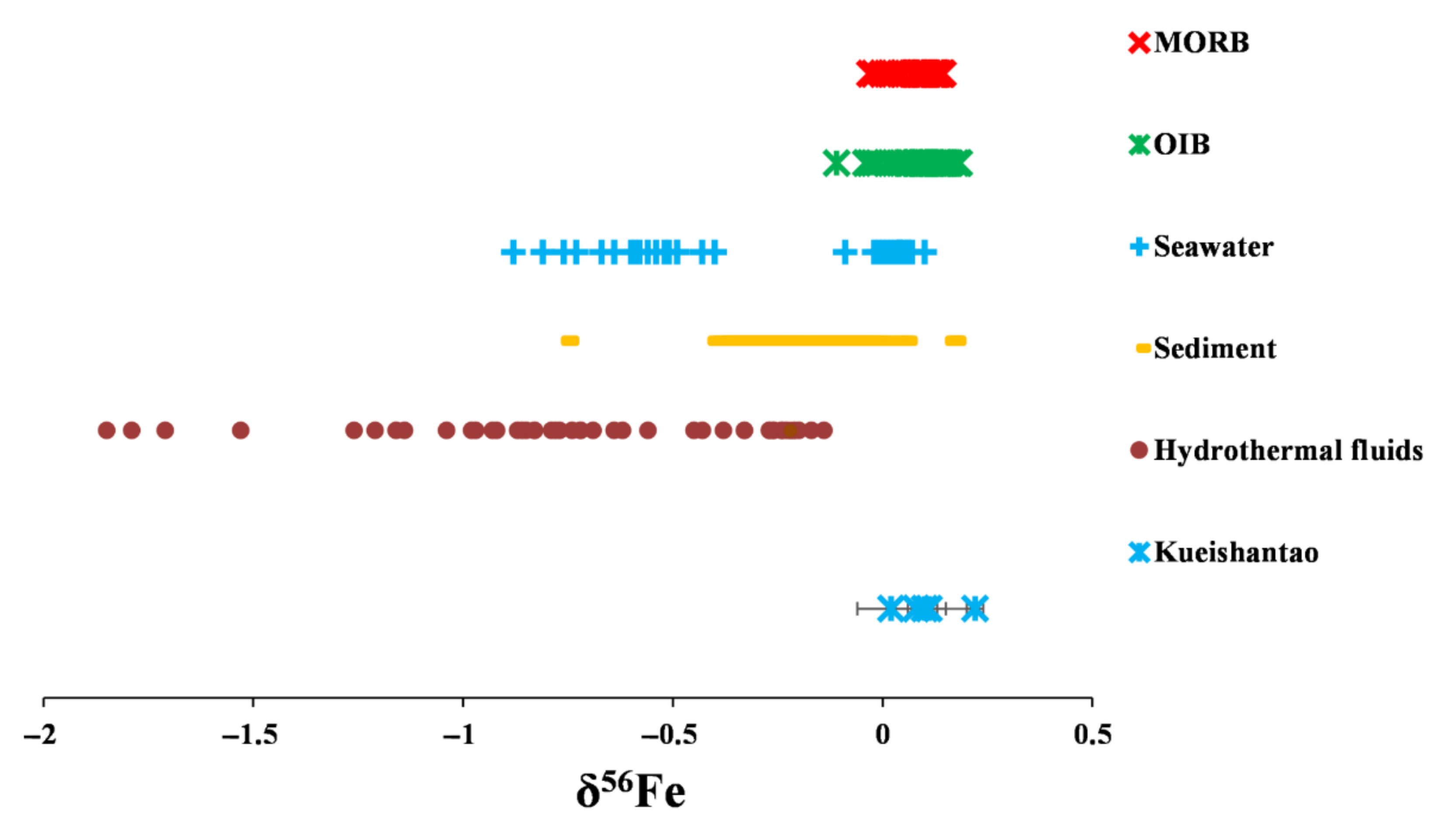
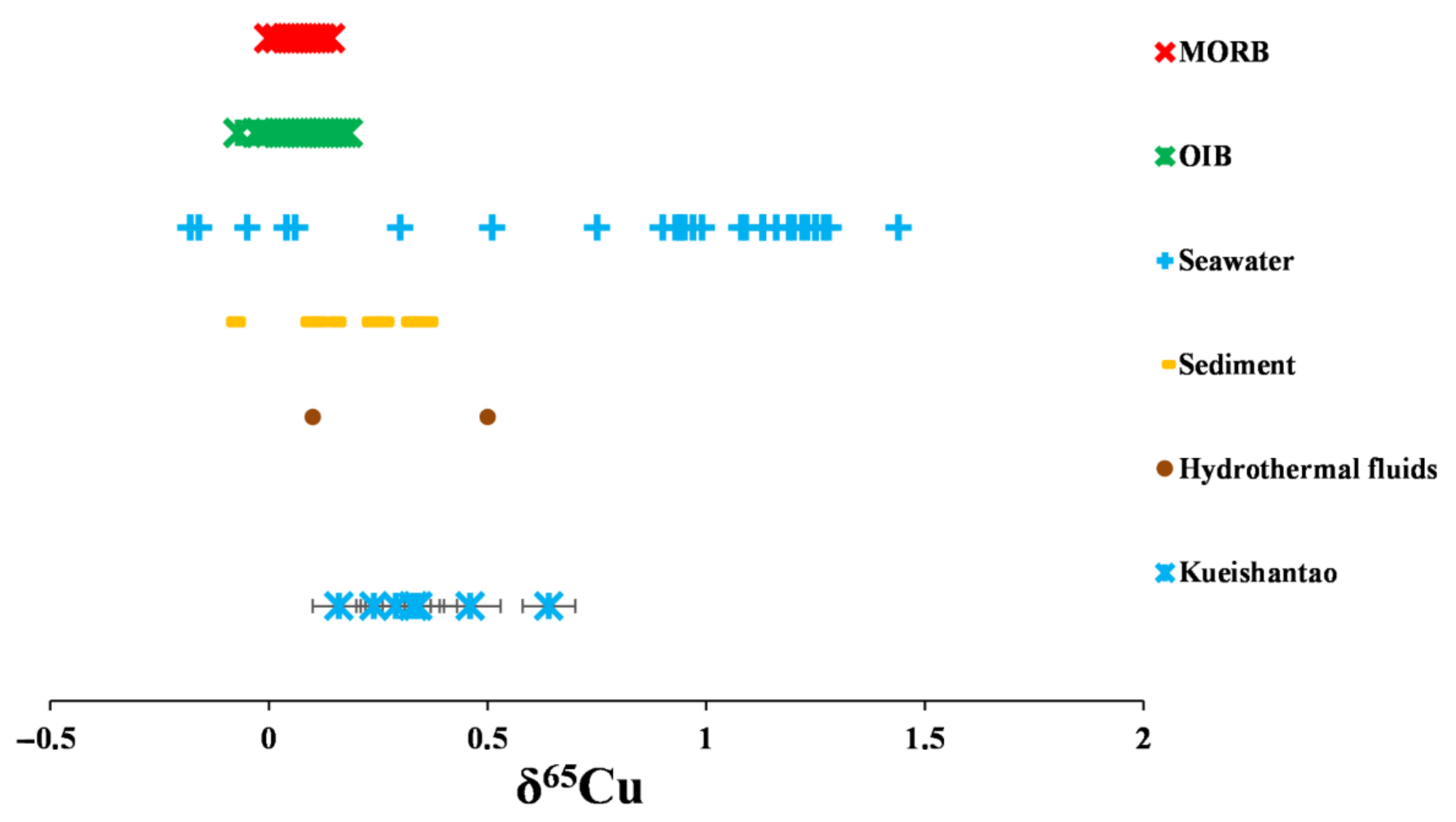
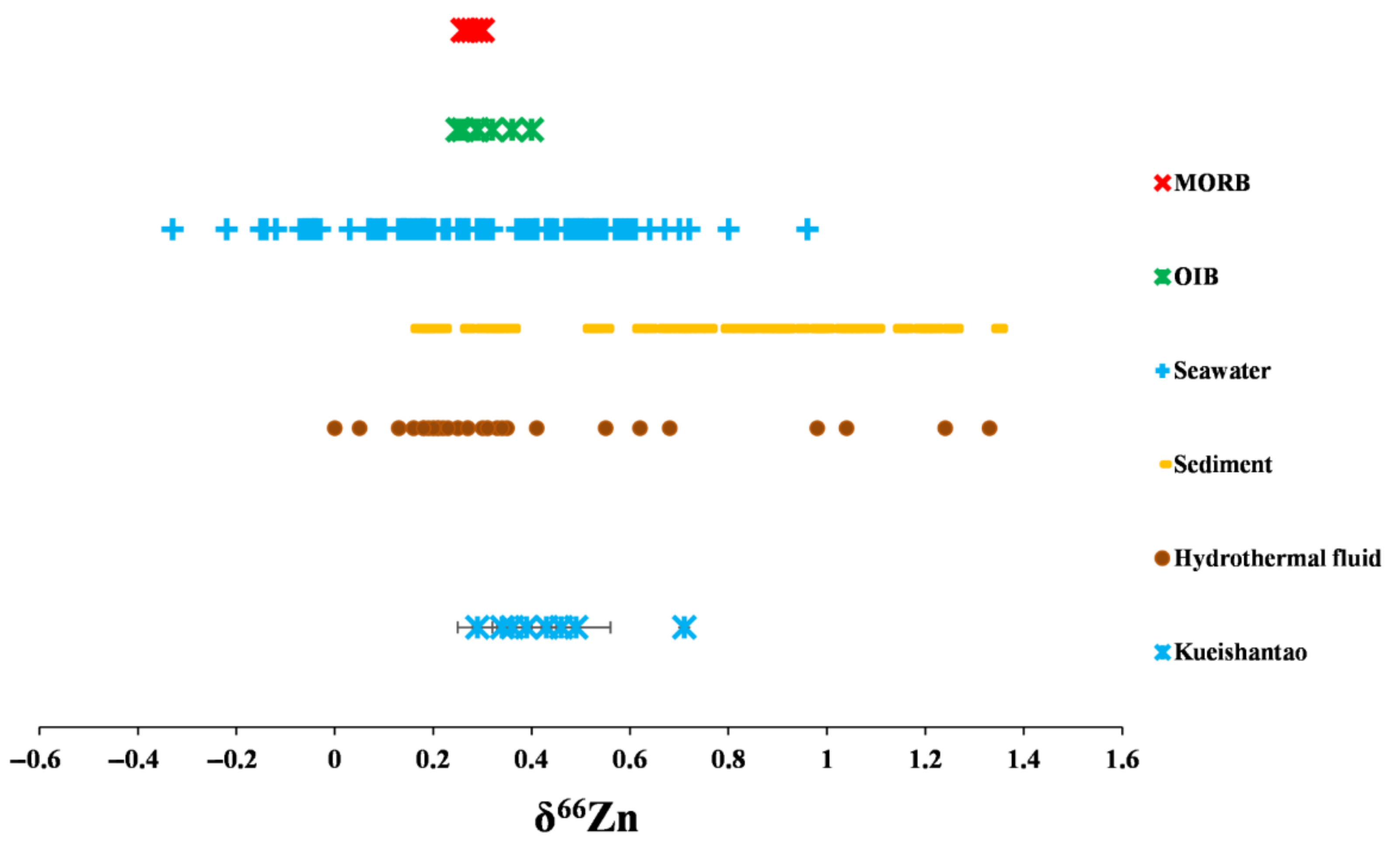
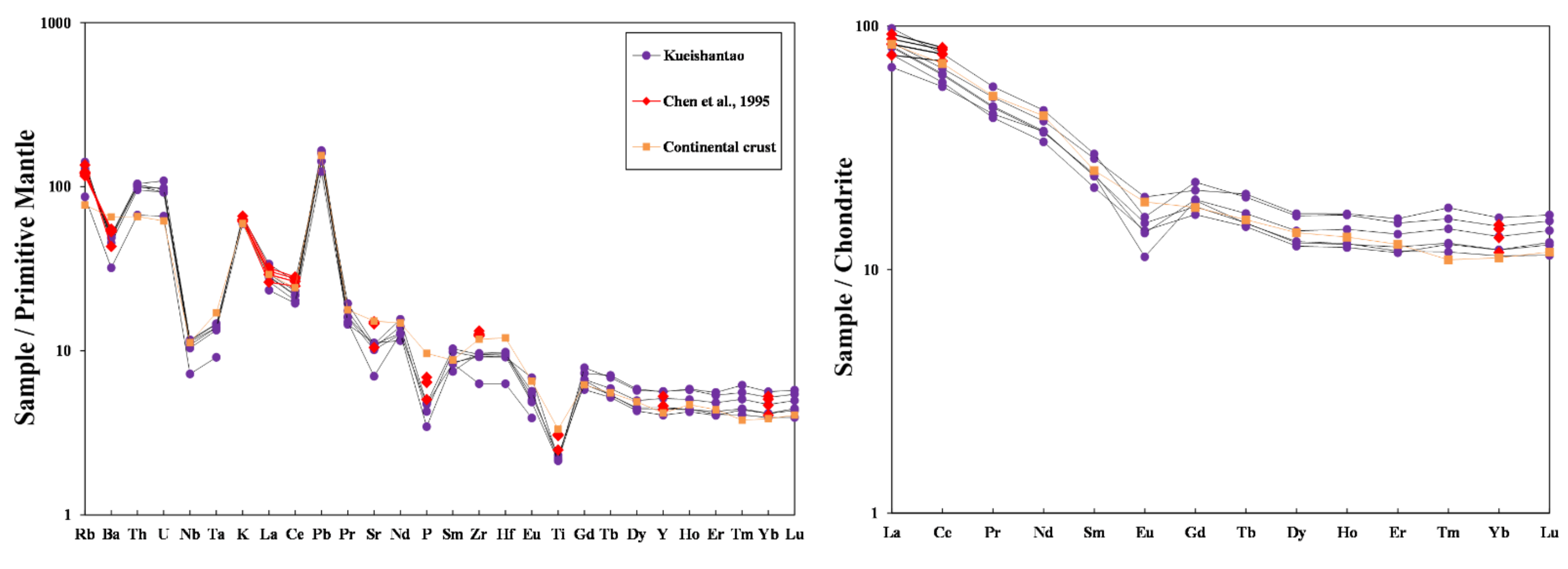
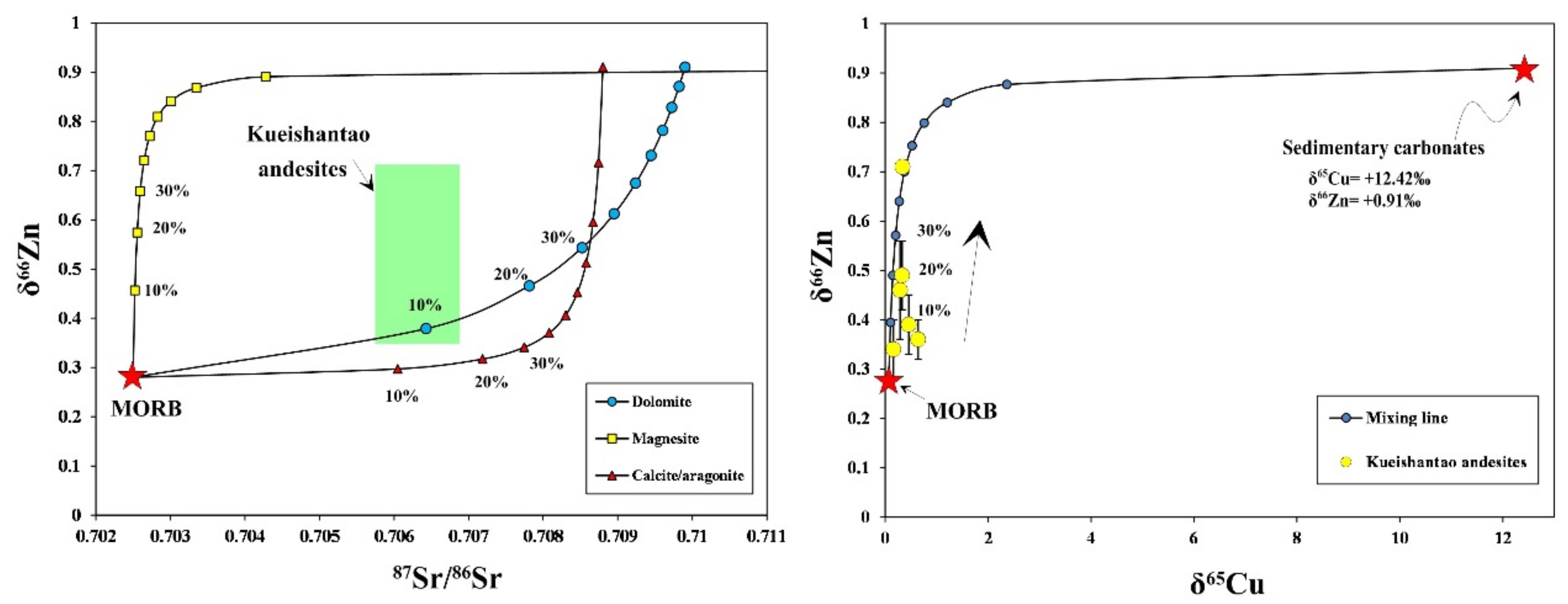
| Sample No. | Latitude | Longitude | Water Depth (m) |
|---|---|---|---|
| K11-W0-R1-2 | 24.83412° N | 121.96196° E | 15.1 |
| K11-W0-R2-2 | 24.83412° N | 121.96196° E | 15.1 |
| K11-W5-R1-2 | 24.83412° N | 121.96196° E | 15.1 |
| K11-W5-R2-2 | 24.83412° N | 121.96196° E | 15.1 |
| K11-Y5-R1-2 | 24.8349° N | 121.96194° E | 7.2 |
| K11-Y5-R2-2 | 24.8349° N | 121.96194° E | 7.2 |
| Sample Name | δ56Fe | 2SD | δ57Fe | 2SD | N | δ65Cu | 2SD | N | δ68Zn | 2SD | δ66Zn | 2SD | N |
|---|---|---|---|---|---|---|---|---|---|---|---|---|---|
| K11-W0-R1-2 | 0.08 | 0.05 | 0.1 | 0.09 | 4 | 0.33 | 0.07 | 3 | 1.07 | 0.14 | 0.49 | 0.07 | 3 |
| K11-W0-R2-2 | 0.02 | 0.08 | 0.06 | 0.1 | 3 | 0.46 | 0.07 | 3 | 0.85 | 0.04 | 0.39 | 0.06 | 2 |
| K11-W0-R2-2 a | 0.02 | 0.08 | 0.04 | 0.02 | 3 | 0.33 | 0.1 | 3 | 0.66 | 0.03 | 0.29 | 0.04 | 2 |
| K11-W5-R1-2 | 0.08 | 0.07 | 0.13 | 0.11 | 6 | 0.34 | 0.03 | 3 | 1.55 | 0.07 | 0.71 | 0 | 2 |
| K11-W5-R2-2 | 0.11 | 0.1 | 0.15 | 0.05 | 3 | 0.64 | 0.06 | 3 | 0.82 | 0.1 | 0.36 | 0.04 | 2 |
| K11-Y5-R1-2 | 0.08 | 0.02 | 0.11 | 0.05 | 3 | 0.29 | 0.08 | 3 | 1.09 | 0.15 | 0.46 | 0.1 | 2 |
| K11-Y5-R1-2 a | 0.1 | 0.03 | 0.13 | 0.11 | 3 | 0.24 | 0.04 | 3 | 0.9 | 0.16 | 0.43 | 0.01 | 2 |
| K11-Y5-R2-2 | 0.22 | 0.02 | 0.34 | 0.11 | 3 | 0.16 | 0.06 | 3 | 0.68 | 0.21 | 0.34 | 0.06 | 2 |
| Reference materials | |||||||||||||
| IRMM-014 | 0.00 | 0.08 | 0.01 | 0.10 | 43 | ||||||||
| MIX | −1.55 | 0.09 | −2.27 | 0.13 | 29 | ||||||||
| Average Quality control ‘Mix’ on Nu Plasma I | −1.53 | 0.07 | −2.26 | 0.15 | 6 | ||||||||
| JMC Cu110 in-house solutions | 1.06 | 0.16 | 30 | ||||||||||
| SRM NIST 976 Cu | −0.97 | 0.13 | 27 | ||||||||||
| BHVO-2 | 0.00 | 0.07 | 9 | ||||||||||
| JMC Zn310 in-house solutions | −0.20 | 0.10 | −0.10 | 0.06 | 20 | ||||||||
| IRMM-3702 Zn | 0.63 | 0.16 | 0.32 | 0.08 | 8 |
| Samples | Kueishantao Andesite | MORB a | fCC b | CC | ||||||
|---|---|---|---|---|---|---|---|---|---|---|
| δ56Fe | δ65Cu | δ66Zn | δ56Fe | δ65Cu | δ66Zn | δ56Fe | δ65Cu | δ66Zn | ||
| K11-W0-R1-2 | 0.08 | 0.33 | 0.49 | 0.105 | 0.07 | 0.28 | 0.3 | 0.02 | 0.94 | 0.98 |
| K11-W0-R2-2 | 0.02 | 0.46 | 0.39 | 0.105 | 0.07 | 0.28 | 0.3 | −0.18 | 1.37 | 0.65 |
| K11-W5-R1-2 | 0.08 | 0.34 | 0.71 | 0.105 | 0.07 | 0.28 | 0.3 | 0.02 | 0.97 | 1.71 |
| K11-W5-R2-2 | 0.11 | 0.64 | 0.36 | 0.105 | 0.07 | 0.28 | 0.3 | 0.12 | 1.97 | 0.55 |
| K11-Y5-R1-2 | 0.08 | 0.29 | 0.46 | 0.105 | 0.07 | 0.28 | 0.3 | 0.02 | 0.80 | 0.88 |
| K11-Y5-R2-2 | 0.22 | 0.16 | 0.34 | 0.105 | 0.07 | 0.28 | 0.3 | 0.49 | 0.37 | 0.48 |
Publisher’s Note: MDPI stays neutral with regard to jurisdictional claims in published maps and institutional affiliations. |
© 2021 by the authors. Licensee MDPI, Basel, Switzerland. This article is an open access article distributed under the terms and conditions of the Creative Commons Attribution (CC BY) license (https://creativecommons.org/licenses/by/4.0/).
Share and Cite
Zeng, Z.; Li, X.; Chen, S.; Zhang, Y.; Chen, Z.; Chen, C.-T.A. Iron-Copper-Zinc Isotopic Compositions of Andesites from the Kueishantao Hydrothermal Field off Northeastern Taiwan. Sustainability 2022, 14, 359. https://doi.org/10.3390/su14010359
Zeng Z, Li X, Chen S, Zhang Y, Chen Z, Chen C-TA. Iron-Copper-Zinc Isotopic Compositions of Andesites from the Kueishantao Hydrothermal Field off Northeastern Taiwan. Sustainability. 2022; 14(1):359. https://doi.org/10.3390/su14010359
Chicago/Turabian StyleZeng, Zhigang, Xiaohui Li, Shuai Chen, Yuxiang Zhang, Zuxing Chen, and Chen-Tung Arthur Chen. 2022. "Iron-Copper-Zinc Isotopic Compositions of Andesites from the Kueishantao Hydrothermal Field off Northeastern Taiwan" Sustainability 14, no. 1: 359. https://doi.org/10.3390/su14010359
APA StyleZeng, Z., Li, X., Chen, S., Zhang, Y., Chen, Z., & Chen, C.-T. A. (2022). Iron-Copper-Zinc Isotopic Compositions of Andesites from the Kueishantao Hydrothermal Field off Northeastern Taiwan. Sustainability, 14(1), 359. https://doi.org/10.3390/su14010359







